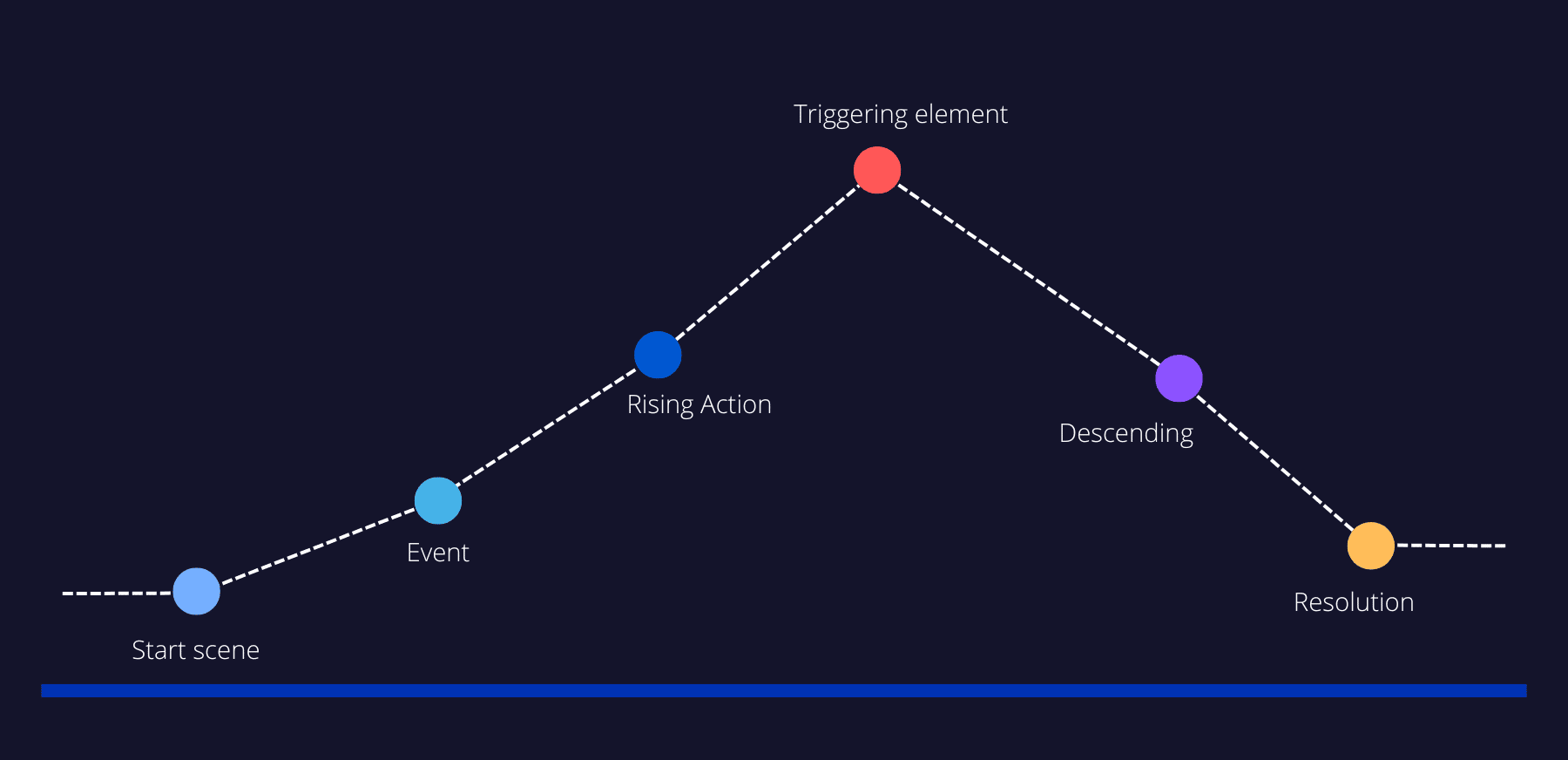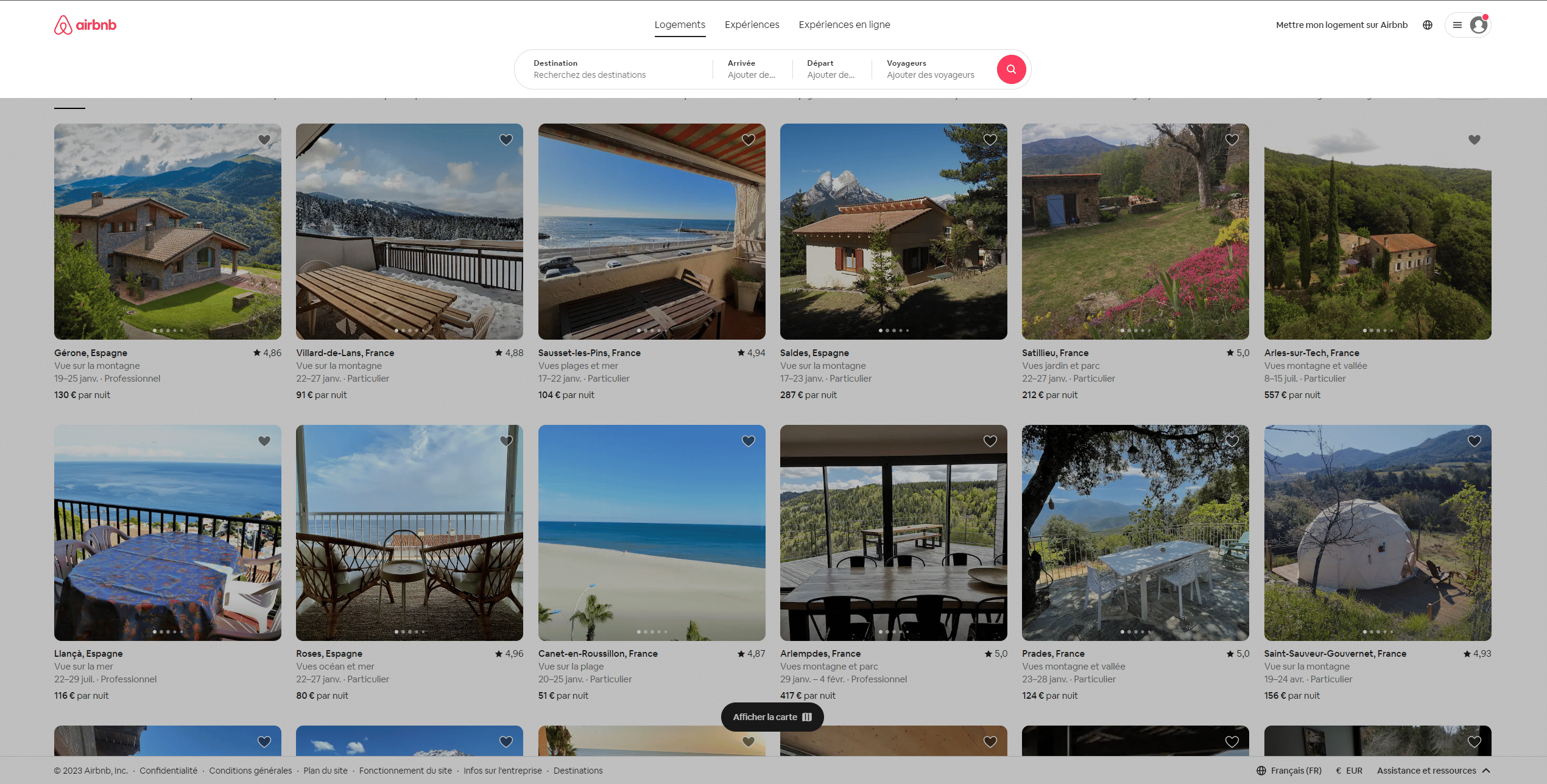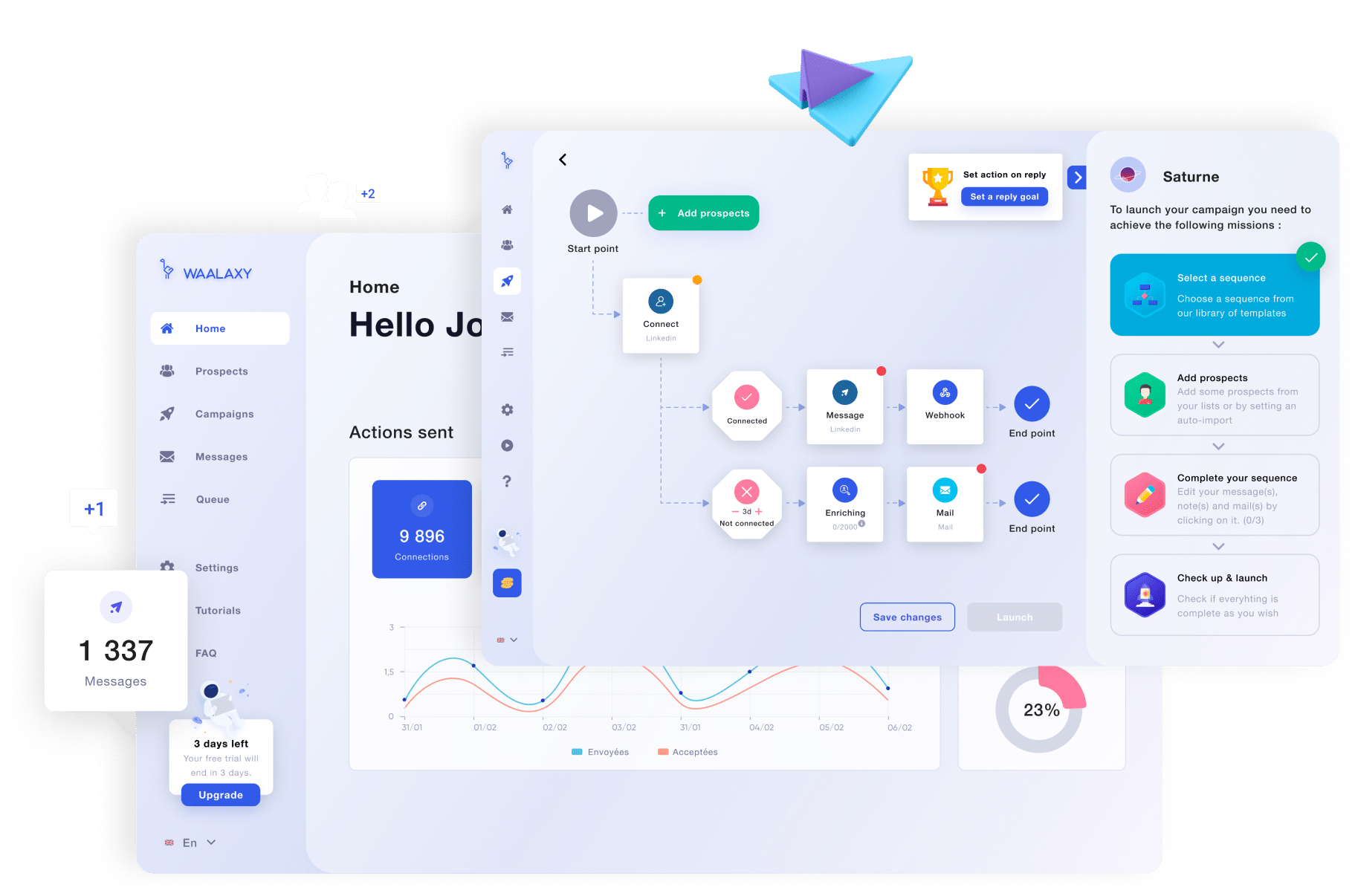Do you have the soul of a storyteller in you and want to use it for everything in your marketing? Then it’s a good thing 🙂 because we’re going to talk about storytelling today. Let’s get started.
Over the course of this article, we’ll look at:
- The definition of storytelling.
- Why do storytelling?
- How to implement it?
- Storytelling in a marketing strategy.
- The best examples.
Storytelling : definition
Storytelling, or the art of telling stories, is a communication technique that consists in presenting an idea 💡, a product or whatever you want in the form of a story. Its literal translation comes from story and telling. Companies often use it to their advantage in order to reach their target in order to sell a product or a service or simply in order to gain visibility.

The main objective is to capture the attention of your audience and to make them adhere to your message. This message should be pleasant and memorable. There are many ways to use storytelling such as :
- Marketing.
- Advertising.
- Journalism.
- Sales.
- And so on…
By implementing storytelling, you will give meaning and value 💎 to your product or service, and arouse emotion in your target. Now that we’ve seen what the definition of storytelling is, how do you implement it in a communication?
What is the purpose of storytelling?
When you want to connect with your audience, storytelling is an extremely useful tool. It will allow you to capture the attention of your prospects, to better exchange with them, to convert them into customers and then into ambassadors.
This will allow you to create a link and therefore to better sell your products or services afterwards.
The goal of this term is to convey a message that speaks to your target 🎯 to make your communication more impactful in order to reach a maximum of people.
What are the 4 fundamentals of storytelling?
As we just explained to you, there are storytelling fundamentals that are best applied to prevent your target 🎯 from missing the message. This is exactly what we explained to you in the point just above. As a storyteller, you’re going to have to work hard on the following:
- Characters: They are the ones who will be used as examples by your targets. To do a good storytelling, you will have to think about your characters. Your targets will identify with them.

- Your environment: your characters will evolve in an environment that may be familial, or festive… In any case, it is the environment that will make your targets feel close to the story you are going to tell.
- The trigger: As we said above, this is what will give meaning to your story. This trigger will give color to your characters since they will certainly question themselves. You are going to trigger emotions for them 💗(maybe the same ones you want to trigger in your audience).
- The denouement : This is what will release the tension but also give meaning to your story. The denouement is when your story will make an impact on your audience.
How to implement storytelling?
For you to be able to get the message you want to sell 💰 your products or services, you’re going to have to put some steps in place namely:
- Identify your target audience and make your persona. You won’t be able to sell a product if you don’t know who you are selling to. Then determine what type of story might be most appropriate for your target.
- Define your objectives and key message. What do you want your potential customers to remember about you? What about your story?
- Choose the tone and style of your story. Will you be emotional? Will your storytelling be humorous? Dramatic?
- Set up the structure of the story. Will it be classic? Original?
- Write 🖊️ your story and put it in shape. Then put yourself in the shoes of someone who would listen to this story and ask yourself if you like it.
- Use visuals to illustrate your story.
- Be careful with your presentation and posture when telling a story.
- Be able to captivate your audience.
How to write a storytelling
To tell a story that reaches a target 🎯 you’re going to need a little preparation. So we’re going to give you all the essential steps you need to take to be successful.
#1 The persona
Every time, it’s always the same old story, you’re told about the importance of creating a typical portrait of your ideal customer. It’s not for nothing, we can assure you. Drawing up this portrait will allow you to respond to needs, pain points and find solutions to the problems that your customers may encounter.
In the case of storytelling, it’s the same thing, how can you create content that touches your targets if you don’t know what drives them, what touches them, what they like? To make your persona, you will have to define the traits of your potential customer, namely :
- First and last name.
- Age.
- Gender.
- Marital status 💍.
- Location.
- Her needs.
- Her pain points.
Of course, you can continue to embellish your persona with details, the more detailed it is, the more likely you’ll reach them.
#2 Choose the tone of your message
How will you express yourself to your target? Is it through humor? Sadness? Here, you need to ask yourself what emotion you want to convey to your audience? This is a key element of your storytelling because it is thanks to this that you will arouse an emotion in your audience. In addition to the tone, don’t hesitate to think about the language register you will use. Will it be sustained? Or on the contrary, familiar?
#3 The message
Now that you know how you are going to address your target 🎯, you also need to focus on the message you want to leave with your audience. The goal is for you to be able to tell a story to sell better. So your message needs to be on point. What do you want to do? Raise awareness about one of your products? Connect with your audience? Inform about a new product? For you to be successful in conveying your message, keep in mind that it must be clear and easily understood by those who will be listening and/or viewing it.
#4 Define the objectives
You have decided to reach your targets but what are your objectives? Do you want to promote your brand? Do you want to gain visibility 👀 and awareness? Do you want to increase your sales? By setting up your goals, you’ll be able to put the right spin on your storytelling and better reach your audience. If you can do that, then achieving your goals shouldn’t be too difficult.
#5 Sharing your story
Prepare for when you will share your story. Choose the date, the format of distribution (written? Video? Audio?), all of which will help you prepare. Keep in mind that you need to share a sincere and authentic story 💗. If you tell a story but do the complete opposite in your actions, your customers will absolutely not trust you and it will not benefit you in any way.
Storytelling arc
In storytelling, we sometimes speak of a narrative arc or story arc. This term refers to the structure of a story and this arc will be made up of events in the story, we can say that it is the progression. You have a rather calm beginning, then an element that comes to disturb the characters, conflicts that will reach a peak and finally an end where everything is resolved. So that you can better understand what we are talking about, we are going to present you with a little diagram.

You will find :
- The starting scene.
- An event.
- The rising action.
- The triggering element.
- The descent.
- The resolution.
So you have a whole narrative arc of a story.
Why do storytelling?
It’s not just about storytelling, telling a story in a vacuum and for fun. Obviously, there are objectives to achieve and it can be very beneficial for your business. The first thing to know is that storytelling helps you capture the attention of your audience by presenting your message in the form of a story 📖.
This way of presenting your product or service also allows you to make sense of what you are offering to your target. Through storytelling, you allow your customers to understand why what you do is important and how it can help them in their daily lives.

But that’s not all, as this way of telling your story can also create trust in the eyes of your audience. When you share authentic and personal stories, you can show your sincerity. If you can create trust with your customers, they will come back to you more easily and will also be more likely to recommend you.
Moreover, you can easily stand out from the competition by telling original and innovative stories that your customers 🎯 can relate to.
Finally, you can federate around your brand. This is one of the most important facets of storytelling. Being able to generate a community around your brand is the Holy Grail for all marketers and salespeople. That’s why you need to use it to your advantage.
Storytelling in a marketing strategy
We often try to create an emotion in our target audience in order to make them buy from us. Putting storytelling in place in a marketing strategy is a real asset and we explain you why. When we do marketing, what we want is to be able to touch our audience, therefore, we will use authentic stories, which have meaning.
The more inspiring your stories are, the more likely you are to reach your target audience. We spoke to you about persona earlier in this article. It is a must, if you want to sell what you offer, you can’t do without it. How can you meet your target’s needs and frustrations if you don’t know them?
The answer is that you can’t. On the other hand, by knowing your target perfectly, you will be able to use storytelling to your advantage by highlighting the values and benefits of your product. You can tell the story of how you managed to solve one of your customer’s problem, for example.
Marketing strategy: Building your brand with storytelling
With this method, you can create a coherent brand experience. We explain. When you tell your story, it will necessarily be related to your brand identity, and it will have to be presented in the same way on all your marketing channels. Don’t hesitate to use emotion in your storytelling, it must be memorable and must make sure that it is remembered.
Don’t forget to work on your creativity 🧠. It’s important to set up original things. Doing the seen and seen again will bring you very little benefits.
The objectives of storytelling in marketing
Behind this term are hidden many objectives, especially in marketing. We can have different objectives, such as:
- The sales discovery of a new product.
- Increasing the visibility of your brand.
- To create a buzz 🛎️.
- Increasing your sales.
Whatever the reasons behind using storytelling, you want to entice your prospect or future customer to come buy from you.
The best examples of brand storytelling
Maybe you’ve never had the opportunity to see the power of storytelling in action, or maybe you haven’t even realized it. Either way, we’re going to show you examples of successful storytelling in the business with well-known brands. We’ll start directly with Airbnb.
Airbnb
If you don’t know this company, Airbnb is a platform that offers you private homes to stay for a while. This platform was founded by Brian Chesky, Joe Gebbia and Nathan Blecharczyk and it exists since 2008.

To reach people, Airbnb relies on the use of several channels such as :
- The blog.
- The various social networks.
- The video.
- Their magazines.
You may not be aware of it, but Airbnb’s beginning is original and the founders don’t hesitate to remind their customers where they come from in order to reach them. Their whole marketing strategy is based on their customers and their own experiences, because Airbnb needs 100% of its customers to remain sustainable.
So it was only natural that this company put their customers first rather than themselves. In order to do effective storytelling, the platform lets customers tell their stories.
There are two benefits to doing this: the first is that you can really play on theemotional based on how your customers felt 🫀. The second benefit is that when your customers are directly recommending you, you’re more likely to be trusted. Bonus point? Having stories of customer experiences can encourage those who haven’t yet jumped in, to do so.
Apple
Whether you like Apple or Android, you’ve already seen at least one Apple ad. This giant has decided to bet on its users in its ads. It is the story that occupies an important place at Apple and what the brand wants is to play on emotions 😍.
More than just phone products 📱 and computers, it’s its entire story that Apple offers to its customers. It works so well that people don’t hesitate to wait 72 hours in front of a store to be able to offer themselves the latest phone of the brand. We are really admiring this work.
Nike
Nike is the sports brand that everyone (or almost) identifies with. Moreover, if we manage to identify ourselves through the stories that Nike tells us, it’s because the brand is excellent in good storytelling. Even when it slips, we still identify with what it conveys.
The first thing to know is that Nike doesn’t hesitate to put forward people who are very little represented in the advertising world. By highlighting these diversities, there are also more people who get to see themselves through their ads. So Nike also plays on the emotions of its viewers in most of its stories.
The storytelling is an excellent method to strengthen its presence on the web, to develop the link with its community, to increase the confidence of its users and to be more clean of its audience.
Write a storytelling that convinces
To tell a story that reaches a target 🎯 you’re going to need a little preparation. So we’re going to give you all the essential steps you need to take to be successful.
#1 The persona
Every time, it’s always the same old story, you’re told about the importance of creating a typical portrait of your ideal customer. It’s not for nothing, we can assure you. Drawing up this portrait will allow you to respond to needs, pain points and find solutions to the problems that your customers may encounter.
In the case of storytelling, it’s the same thing, how can you create content that touches your targets if you don’t know what drives them, what touches them, what they like? To make your persona, you will have to define the traits of your potential customer, namely :
- First and last name.
- Age.
- Gender.
- Marital status 💍.
- Location.
- Her needs.
- Her pain points.
Of course, you can continue to embellish your persona with details, the more detailed it is, the more likely you’ll reach them.
#2 Choose the tone of your message
How will you express yourself to your target? Is it through humor? Sadness? Here, you need to ask yourself what emotion you want to convey to your audience? This is a key element of your storytelling because it is thanks to this that you will arouse an emotion in your audience. In addition to the tone, don’t hesitate to think about the language register you will use. Will it be sustained? Or on the contrary, familiar?
#3 The message
Now that you know how you are going to address your target 🎯, you also need to focus on the message you want to leave with your audience. The goal is for you to be able to tell a story to sell better. So your message needs to be on point. What do you want to do? Raise awareness about one of your products? Connect with your audience? Inform about a new product? For you to be successful in conveying your message, keep in mind that it must be clear and easily understood by those who will be listening and/or viewing it.
#4 Define the objectives
You have decided to reach your targets but what are your objectives? Do you want to promote your brand? Do you want to gain visibility 👀 and awareness? Do you want to increase your sales? By setting up your goals, you’ll be able to put the right spin on your storytelling and better reach your audience. If you can do that, then achieving your goals shouldn’t be too difficult.
#5 Sharing your story
Prepare for when you will share your story. Choose the date, the format of distribution (written? Video? Audio?), all of which will help you prepare. Keep in mind that you need to share a sincere and authentic story 💗. If you tell a story but do the complete opposite in your actions, your customers will absolutely not trust you and it will not benefit you in any way.
Conclusion
We are almost there. So that you have everything that comes back to you, we will recap what we have seen today. So we were able to cover concepts such as:
- The definition of storytelling.
- Its purpose ⚽.
- Why you should do storytelling.
- How to implement it.
- Storytelling in a marketing strategy.
- The best examples of storytelling.
- Writing a storytelling that convinces.
FAQ
We are almost at the end of this article, but there may still be some concepts you can learn. That’s what we’re going to do.
How to define storytelling?
In order to reach an audience, we play with their brain, and more particularly their emotions. Storytelling is the art of telling a story to get a message across, to sell a product, to make yourself known, to create a buzz. It is a communication technique that will provoke an emotion towards the product or the service or even the brand.
There are several objectives when we put storytelling in place, it will depend entirely on what you want to do and to provoke.
How to make a good storytelling?
The first thing to do when you start this kind of exercise is to know your target. How can you know that you will reach an audience if you don’t know what drives your target, what could trigger emotions? If you know how to trigger emotions in your target, they will be more sensitive to your brand and what you offer. Then you need to find the right story to tell, the one that is worth telling, the one that your audience will recognize themselves in.
That’s how you will succeed in making a good storytelling. These tips are to be done beforehand. To dive directly into the concrete, we will give you the steps to do so that your storytelling is at the top.
#1 Prepare your story
Build your storyline and ask yourself questions such as:
- Where will my story take place?
- What values will I put into the story?
- What will I be able to tell?
#2 Define your characters
In this case, will you focus on one or more characters in your fiction? Will you make your audience recognize themselves in your characters? Are they funny? Sad? What emotions will they exude?
#3 The environment
It’s time to focus on the elements that will reinforce the position of your characters and your story. We’re talking about the scenery, of course, but also the light and the atmosphere that will emanate from it. Don’t hesitate to give as much detail as possible when you expose your scenes, this will allow your targets to get closer to your brand.
#4 The trigger
You will have to focus on an element that will make the character question himself, or find his way. This is the element that will make your story make sense. It’s an element that will definitely show your character’s motivation 🙂 .
#5 The ending
What is the outcome of this adventure going to be? Of this questioning? The denouement is the most important part of your story, think about it so that it makes the biggest impact on your audience.
When to use storytelling?
There are many cases in which storytelling can be used and we will list them now:
- The presentation of a product or service (you can tell a story that highlights the benefits and values 💰 of your offer. You will help them understand why your product or service is important and how it can improve their daily life).
- Communicate 👄 about your brand. You will highlight your brand’s values and identity through communication that will reach your audience.
- Present a project or an idea. Indeed, you don’t have to use it only when there are customers at stake. You can also use this method to present an idea. You will have to convince your audience by arousing their interest and getting them to buy into your project.
- Sell a product or service.
- Motivate or inspire: you can inspire your audience by sharing a story that evokes emotion.
Of course, there are other times when you can use storytelling. Use it when you feel it’s the right time.
Data Storytelling
Is this the first time you’ve heard this term? Don’t worry, it’s very easy to understand. Data storytelling is telling a story with graphically represented data. Now, maybe it doesn’t ring a bell, but if you’ve ever given a presentation at school or in a company, we’re sure you’ve already done some data storytelling. For example, if you have decided to talk about the evolution of the company through numbers and you present them with graphs, you are doing data storytelling. Of course, to facilitate this data storytelling, there are quite a few tools 🧮 that have emerged.
That’s it, we’ve come to the end of this article and you now know everything there is to know about storytelling.









